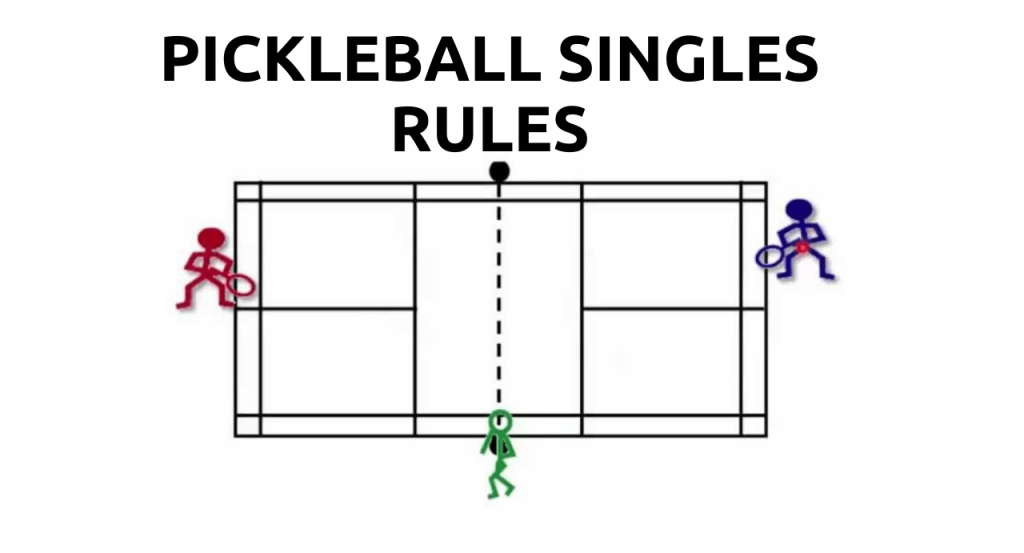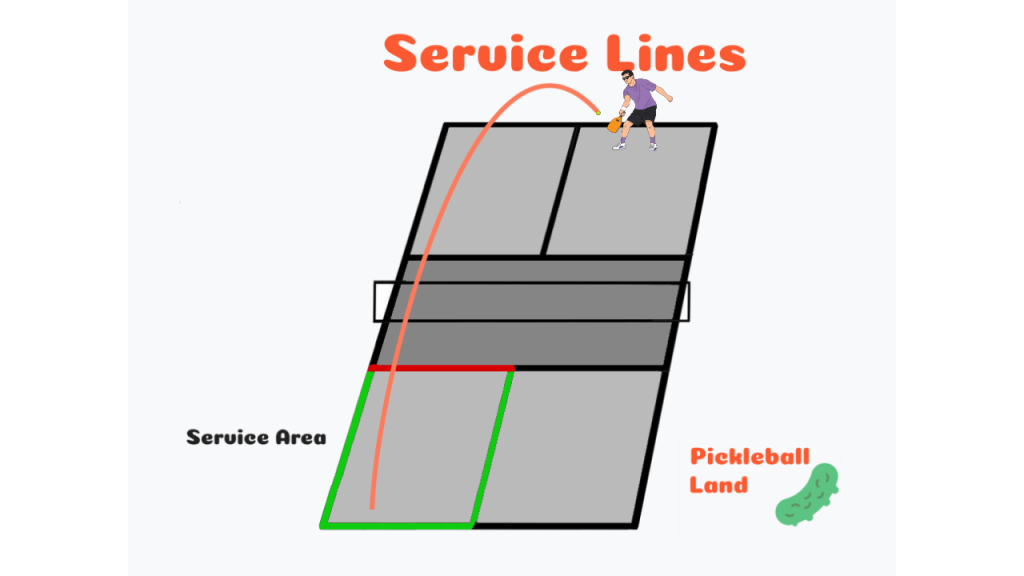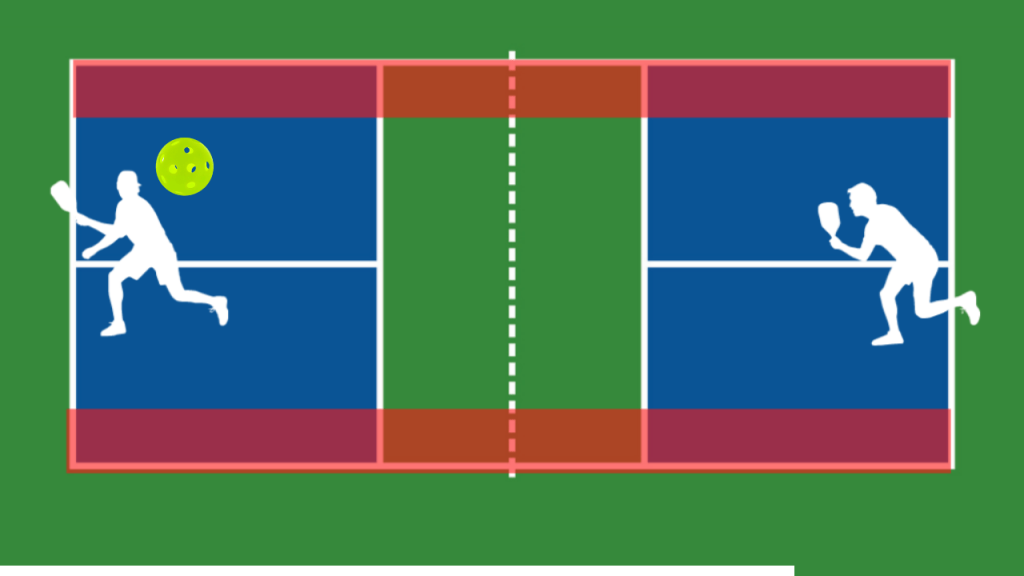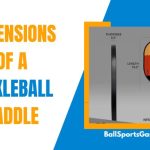Players enjoy pickleball for its combination of tennis, badminton, and ping pong elements and often play it in a doubles format. For those who seek a more individualized challenge, singles pickleball is also popular.
Start your singles pickleball match by serving diagonally across the net and into your opponent’s court. Stand behind the baseline and hit the ball underhanded, then score points for each rally you win. Keep playing until you reach 11 points with a 2-point lead to secure a victory!
Players must be strategic and mindful of the different zones on the court and have good footwork and quick reflexes to move around the court and return the ball effectively.

Singles pickleball is a fun and engaging sport that provides a great workout and plenty of excitement. It’s a great way to challenge your skills and improve your game while meeting new people and staying active. So grab a paddle, hit the court, and give singles pickleball a try.
Rules of Pickleball Singles
In singles pickleball, there is only one player on each side of the court. In singles, the strategy is different from doubles. Singles pickleball can be quite the workout and more enduring than doubles pickleball. It is a game that most pickleball players likely have a love-hate relationship with.
You must endure the rigorous and challenging nature of singles pickleball alone. Covering the entire court solo, you’ll receive a full-body workout while honing your skills and strategy. Though it can be isolating without a partner to rely on, you’ll reap the rewards of your hard work and determination.
Overall, singles pickleball can provide an exciting challenge for those looking to improve their game and take their skills to the next level. It’s a great way to stay active, meet new people, and push yourself to new limits. So why not give it a try and see how you fare on the singles court?
Simple 5 Pickleball Singles Rules
- Singles pickleball differs from doubles pickleball in two ways. Firstly, each player only gets one serve, unlike doubles pickleball where players get two serves each.
- Secondly, the scoring system in singles pickleball only consists of two numbers, as there is no need for the third number that signifies which player is serving.
- The two numbers in the score represent the server’s score followed by the opponent’s score, as per the USA Pickleball Association Rule 4.I. This means that when announcing the score, only two numbers are mentioned.
- In singles pickleball, each player serves only once, and when they lose a rally, the ball goes to the opponent.
- In absence of a second player means that the third number used to signify the server in doubles is unnecessary in singles.
Therefore, singles pickleball can provide a unique challenge for players who are used to playing doubles. With only one player on each side, the game requires more physical endurance and a greater emphasis on individual strategy. By understanding the key differences between singles and doubles pickleball, players can improve their skills and become a more well-rounded player.
How to Play Singles Pickleball
Pickleball singles are not much different from doubles, but there are certain rules which we should consider before playing singles. Let us discuss that one by one.
Serving

- In pickleball, serving plays a crucial role in starting each point. The server must follow specific rules to make the service legitimate.
- Firstly, the server must be underhand, and the paddle contact with the ball should be below the server’s waist.
- Secondly, when serving, at least one foot must be behind the baseline, and neither foot can touch the baseline or the court until after hitting the ball.
- The serve should be made diagonally crosscourt and land in the opposite diagonal court.
- Players only get one serve attempt, except for when the ball hits the net and lands in the proper service court on the other side, which is known as a “Let.
- It is important to note that a let serve doesn’t count as a fault and does not result in the loss of the serve.
By following these specific serving rules, players can ensure a fair and competitive game of pickleball.
Serving Sequence
- Serving plays a crucial role in starting each point. The first service of each game singles and doubles is an exception, where only one player from the initial serving team gets to serve before the service passes to the other team.
- After each service, the players switch sides of the court. Every time service changes sides, the first serve is from the right-hand court. When the serving team scores a point, they switch sides of the court for the next serve.
- In doubles play, when the first server loses the serve, their partner moves to serve from the same side of the court their partner had last served from.
- In singles play, the server serves from the right side of the court when their score is even and from the left side when their score is odd.
- By following these specific serving rules, players can ensure a fair and competitive game of pickleball. It is important to note that each player’s turn to serve must be taken in turn without any interference from the other player.
Scoring
- In this game, only the serving team can score points. Games are usually played to 11 points, and the winning team must have a two-point advantage to win the game. However, in tournament play, games may be played to 15 or 21 points. Again, the winning team must have a two-point lead to win the game.
- Call out the score before every serve when playing a game. Make sure to announce the server’s score first, followed by the receiver’s score, for it is essential to keep track of the score and abide by specific rules.
- Knowing the rules of scoring is essential to winning a game of pickleball. The game is highly competitive, and every point counts. By understanding the scoring system, players can strategize their moves and aim to take the lead early on to secure a victory.
Double Bounce Rule
- there are specific rules that determine when the ball can be returned. The receiving team must let the ball bounce before hitting it back. The serving team must likewise let it bounce before returning it when the ball is served.
According to Wikipedia “Once the receiver has returned the ball over the net, the serving side must also allow the ball to bounce once before returning the ball to the non-serving side. This is known as the two-bounce rule.“
- However, after the initial two returns, players can hit the ball using a groundstroke or a volley. A groundstroke is when the ball bounces first before being hit. While a volley is when the ball is hit in the air without bouncing.
- It is crucial to understand these rules to be successful in the game of pickleball. Players must strategize their shots and anticipate the movement of the ball to ensure they return it within the rules. By mastering the groundstroke and the volley, players can keep the game going and increase their chances of scoring points.
Volleys
- The area within 7 feet of the net on both sides of the court is known as the “kitchen” or the non-volley zone. It is not allowed to Volleying the ball within the kitchen. This rule prevents players from performing smashes from the net.
- A line on pickleball courts marks the non-volley zone, and it is a fault to step into the zone or even on the line while volleying.
- Even if your momentum carries you into the kitchen or causes you to touch the line after a volley, it is still a fault. It’s okay to be in the non-volley zone at any other time as long as you’re not volleying the ball.

Line Calls
- When a ball contacts any line, it is considered in. It does not only when the non-volley zone line on a serve, causes a fault.
- If a serve contacts the non-volley zone line, it is short and also results in a fault.
Read More : How many calories is burned in pickleball
Faults
Players can fault in various ways during a game:
- Failing to serve the ball within the receiving court
- Hitting the ball into the net on the serve or any return
- Volleying the ball before a bounce has occurred on each side
- Hitting the ball out of bounds
- Volleying the ball from the non-volley zone
- Allowing the ball to bounce twice before returning
- Touching the net or the net post with any part of the player, player’s clothing or paddle when the ball is in play
- Violating a service rule
- A player is struck by a ball or by anything they are wearing or carrying.
- Striking any permanent object before the ball bounces on the court.
Determining Serving Team
- Before the game starts, a coin toss determines the first serve. The winner of the coin toss has the advantage of choosing either to serve or receive and select which side of the court they prefer to start the game on.
- This decision can often have a significant impact on the outcome of the match. By this, the winning team chooses the strategy that best suits them.
Pickleball Singles Strategy Tips
Playing singles pickleball involves a distinct set of rules compared to doubles pickleball and requires a different strategy for success.
If you’re planning to participate in a singles pickleball match, it’s important to focus on mastering certain aspects. Like following key factors that are critical to achieving success on the court.
- To give yourself an edge over your opponent from the very first shot, it is essential to have a
- big, deep serve in singles pickleball. You need to use the service effectively to dominate the game.
- Big, Deep Return of Serve is equally important in singles pickleball as it allows you to move into the Non-Volley Zone line, also known as the Kitchen line, and cut off your opponent’s angles on the third shot. To achieve this, be sure to return the serve deep into a corner and follow up by moving quickly towards the net.
- If you’re trying t hit a lob shot in pickleball, it refers to a type of shot that is hit high and deep into the opponent’s court. The objective of a lob is to make your opponent move back to the baseline, giving you time to move forward and take control of the net.
- Cutting off your opponent’s angles is crucial in singles pickleball, and to do this, you must work your way into the Non-Volley Zone line. Follow the flight of the pickleball and move into the Kitchen line to reduce your opponent’s options.
- Having strong fundamentals and placement is key in both doubles and singles pickleball, but in singles pickleball, where you are alone on the court, it is even more critical to have solid placement of the pickleball as you do not have a partner to rely on. Focus on your fundamentals to stay on top of your opponent and maintain your lead.
- In singles pickleball, finding an open court is essential. To defeat your opponent, take advantage of any angles and passing shots that arise during the game. By doing this, you can create opportunities to win points and ultimately win the game.
FAQs
In singles pickleball, players must stand behind the baseline and hit an underhand serve diagonally across the court to the opponent’s service box. The server should hit the ball with an underhand stroke and allow it to bounce once before it reaches the other side of the net.
A player scores a point in singles pickleball whenever their opponent fails to return their shot back over the net, or if their opponent commits a fault (such as stepping on or over the non-volley line).
Each player gets two serves per rally in singles pickleball, meaning that if they miss both attempts at serving then they have lost that particular point and their opponent will be awarded one point instead.
When playing dink shots in singles pickleball, players can only hit the ball once before it crosses over to their opponent’s side of the court; otherwise, they will have committed a fault and their opponent will receive one point instead of them scoring one point for themselves.
The 7-foot non-volley line, also known as “the kitchen,” is a physical line that runs across the width of the court seven feet from the net. Players are not allowed to volley (hit a shot without letting it bounce first) when they are standing within this area; otherwise, they will be committing a fault.
Conclusion
Play singles pickleball for an incredibly fun game with the same rules as doubles. You’ll use the same court, paddle size, and underhand serving. The biggest difference is that you’re playing against one opponent and the court is smaller.
Implement basic strategies such as hitting deep, controlling shots, using angled shots, and keeping your opponent off balance to become an expert at singles pickleball with practice. Therefore, whether you play singles or doubles, the game will not change its nature of competitiveness.



